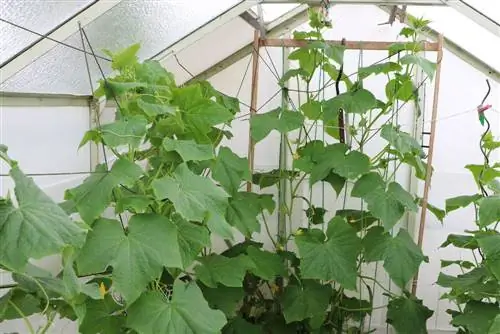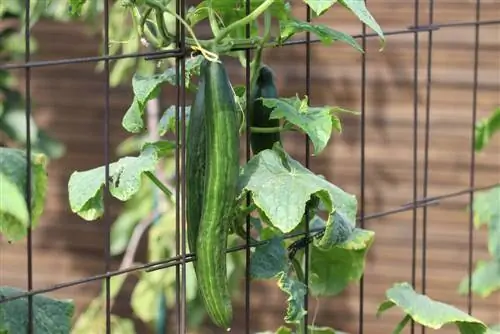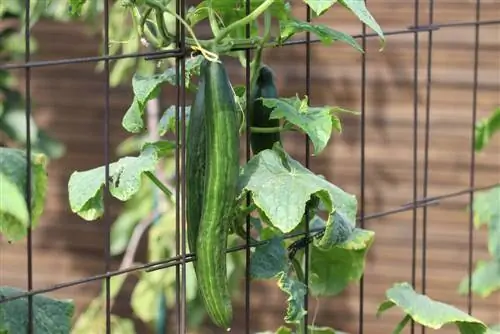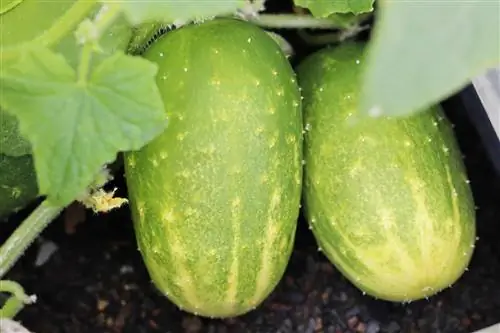- Author admin [email protected].
- Public 2023-12-17 03:39.
- Last modified 2025-01-24 12:45.
The cucumber (Cucumis sativus) belongs to the Cucurbitaceae (pumpkin family). It is versatile and, above all, easy to grow. Cucumbers are annual, can creep and climb, and are pickled or eaten fresh. As snake cucumbers, they are probably one of the most prominent greenhouse vegetables. But the Feiland cucumber also has its advantages and, above all, it can be used for any purpose thanks to a wide variety of cultivated varieties. So that nothing goes wrong, here are some tips for growing and growing from seeds
Seeds or plants
Before we get down to business, there are a few fundamental decisions to be made. Above all, a he althy self-assessment of what you can and would like to do as a hobby gardener. Whether there is a greenhouse, whether, among many other vegetables, a bed with cucumbers should be planted or whether a few containers with cucumber plants are enough to get started.
Seeds
The cucumber is a monoecious plant with male and female flowers. New varieties are particularly productive because they only have female flowers that no longer need to be heavily pollinated. The expert then speaks of virgin-fruited varieties; each flower produces a fruit. These varieties are available as seeds and as young plants. As a rule, cucumbers are grown from seed. This works best in a greenhouse or if you have enough bright spots on window sills. Getting the young plants used to the outdoors must be done gently because they are very sensitive to temperature. The more robust outdoor cucumbers (pickling cucumbers) can also be sown directly.
Young plants
The cucumber young plants are well suited for beginners. Most of the time these are refinements. A high-yielding cucumber variety is planted on a fast-growing, robust fig leaf pumpkin. The young plants can be planted in the bed or in planters for the balcony or terrace immediately after purchase, but not earlier than mid-May.
Sowing
If you pre-culture cucumber seeds, you can expect an earlier harvest and a longer harvest time. Not all varieties are equally suitable for direct sowing outdoors.
Greenhouse, windowsill
In a greenhouse with heating you can start sowing cucumbers (snake cucumbers) as early as mid-March. If you can only provide a window sill as space for cultivation, you should opt for the more robust outdoor cucumbers (pickling cucumbers). If you let them grow a little larger, they can also be enjoyed fresh raw or in a salad. If a greenhouse is not available, they will not be sown until mid to late April.
Freeland
You should only sow directly outdoors with the robust, small-growing outdoor cucumbers. Sowing can be done directly into the bed from the end of April to the end of June and the beginning of July.
Sowing in pots
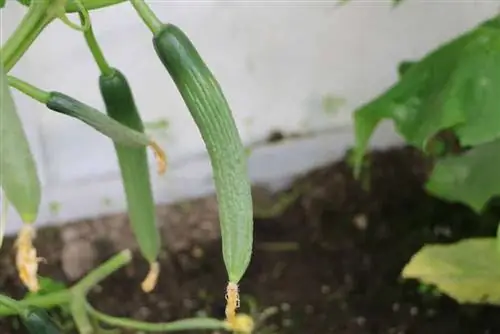
Normally you could start the pre-culture much earlier in the greenhouse or on the windowsill. But if the young plants are then to be placed outdoors, this must happen no later than three weeks after sowing. The germination period is very short at 3 to 4 days. The young plants shouldn't be that big when they go outdoors.
Three to four seeds come in small pots with potting soil. The individual pots should have a diameter of a good eight centimeters. After just four days you can see the earth cracking. It is important to keep them as warm as possible (at least 20°C) until they germinate and then they can tolerate it a little cooler. As soon as the first leaves protrude over the edge of the pot, the weakest seedlings are removed. Then fill the pot a little with soil. Only when the nights are frost-free can the small cucumber plants go outdoors.
Direct sowing outdoors
Prepare small hollows in the bed, at least 30 centimeters apart. Three seeds are placed in a planting hole. You should see seedlings in about 5 to 10 days. Here too, the weakest cucumber plants are sorted out.
Releasing the early plants outdoors
Only when it is really frost-free can the pre-grown plants be placed in the bed. The seedlings should have two well-developed leaves:
- Insert seedlings deep
- Distance from each other 40 cm; Clean distance 100 cm
- optional: place two to three plants per square meter
- don't damage the roots
- hill lightly with soil (to form lateral roots)
- Provide more heat for rooting with glasses or foil
- A garden fleece or black mulch film can also provide warmth
- Cold (below 14°C) leads to stunted growth
Floor
Cucumbers are heavy feeders, they like nutrient-rich, humus-rich and loose soil. If possible, prepare the soil with manure and compost before planting, which is also good for ventilation. To prevent drying out, weeds and to protect the roots, it has proven useful to cover the soil around it with mulch. Cucumbers like neutral to slightly alkaline soil.
Location
Cucumbers need a substrate temperature of 15°C. The location should therefore be warm, sunny and protected from strong winds. Last but not least, this is the reason why cucumbers feel so comfortable in greenhouses. But of course that shouldn't stop anyone from growing the small, crunchy pickling cucumbers in the open air. When choosing the bed, it should be noted that no cucumbers were grown there in previous years. This serves, among other things, to protect against various fungal diseases.
Pouring
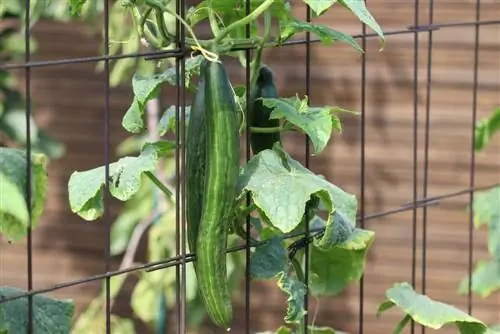
Cucumbers, with their high water content, naturally also require a lot of water. During dry periods and as soon as the first fruits form, watering must be carried out daily. The early morning hours are best for this. The water shouldn’t be too cold either. A layer of straw mulch can somewhat prevent the soil from drying out.
Tip:
Many fungal and bacterial diseases can be prevented with the correct watering behavior. It is best to water cucumber plants so that the leaves get as little moisture as possible.
Fertilize
The cucumber plants have already received their first basic fertilization by thoroughly mixing the soil with compost. When the first fruits form, you can help with organic liquid fertilizer, comfrey manure, nettle manure or horn meal every two weeks. Of course, a normal, ready-made liquid fertilizer for vegetables from the garden store will also work.
vines
The outdoor cucumbers usually grow lengthways along the ground. If you don't have a lot of space or are growing the cucumbers in a planter, you can use a climbing aid (for example made of wire mesh or a trellis) to encourage them to grow taller. Both can be safely created at two meters.
Vertical tendrils are also the better option for the fruits and leaves. This is how you prevent pressure points, damage and contamination caused by the contact with the earth. In professional greenhouse cultivation, the twining shoots are wrapped around a vertically stretched band twice a week. Depending on the growth, the climbing shoots are guided around the trellis.
Cutting
In order to avoid too early fruit development, which could generally weaken the young plants, all side shoots up to a length of 80 cm are cut off. When fruit formation begins, you can also cut off the main shoot so that there is enough strength left for further side shoots and the existing fruits. This can be done with the pickling cucumbers after the sixth leaf.
Varieties
Basically there are over 40 different types of cucumbers. They can be roughly divided into outdoor cucumbers (pickling cucumbers) and greenhouse cucumbers (snake cucumbers). The variety of seed packets is therefore large. Everything is included, from fat braised cucumbers to small snack cucumbers. If you don't have a greenhouse, you should pay attention to its robustness.
Cucumbers that are also suitable for outdoor use
- ‘Gergana’
- ‘Johanna’
- ‘Hoffman’s Giganta’
- ‘Chinese snakes’
- ‘Qualitas’
- ‘La Diva’
- ‘Helena’
- Field cucumbers, mustard cucumbers, pickling cucumbers
- ‘Marketmore’
- ‘Thick Fleshy Yellows’
- ‘Footland Grape’
- ‘Vert Petit de Paris’
- ‘Picklebush’
- ‘Limona’
- ‘White Apple Cucumber’
- Snack cucumber ‘Iznik’
- Snack cucumber ‘Picolino’
Neighbors
A good neighborhood, in time and space, also plays an important role for cucumbers:
Time is important in that no cucumbers should be planted on the same bed for four years. On the other hand, excellent pre-cultures for cucumbers are legumes and celery. As spatial neighbors, cucumbers get along very well with bush beans, onions and peas. Dill and basil in the neighborhood actually strengthen the cucumbers.
Between the rows of cucumber beds, you can also grow quick crops such as lettuce and rocket. Of course, only as long as the cucumber plants are not too big. They don't make good neighbors with tomatoes, potatoes and rosemary.
Harvest
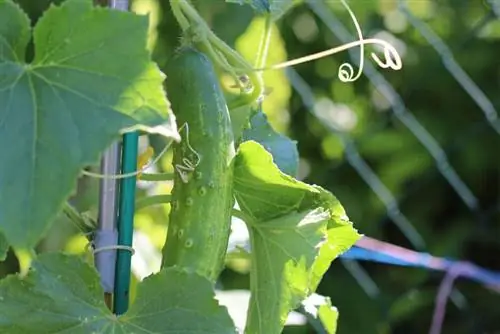
When it comes to harvesting, it's important to stick with it. The first cucumbers can be expected after just six to eight weeks. Those who pick diligently promote the ripening of the following fruits. The small pickling cucumbers ripen daily. Depending on the planting time, you can harvest cucumbers well into October.
Diseases and pests
Powdery mildew
White spots on the leaves indicate an infestation with this fungus. Powdery mildew loves dry and warm weather. It spreads very quickly and, for the sake of enjoying cucumbers, it is better not to experiment with chemical agents. It is therefore best to detect them early enough, dispose of the affected plant parts and ensure sufficient humidity.
Downy mildew
Yellow and brown spots on the leaves in damp, cool weather indicate an infestation with downy mildew. A persistent fungus that spreads quickly. The only remedy is early detection and destruction of the affected leaves. When watering, be sure to keep the leaves dry. It is better to water in the morning than in the evening.
Cucumber mosaic virus
Aphids can transmit this virus. When it's warm, these mosaic-like spots appear on the leaves. The leaves wilt in cool weather. There isn't much that can be done afterwards other than destroying the affected parts of the plant and, above all, fighting the aphids.
Tip:
The best precaution can be taken when selecting cucumber seeds. There are many varieties on the market that are declared robust and resistant.
Conclusion
If you decide to sow the more robust outdoor cucumbers, you don't have to put in too much care. However, the requirements include warmth, regular fertilization and watering. They reward this with rapid ripening and a long harvest time. For growing plants, a mini greenhouse is a good alternative to a windowsill. Strong seedlings, not planted outdoors too early, are a good prerequisite for a rich harvest.

